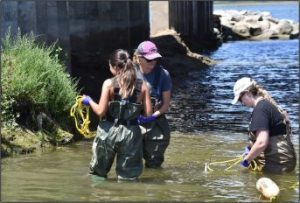Second phase launched for Newport Bay study revisiting shellfish water-quality standard

SCCWRP and its partners have launched the second and final phase of a study examining whether an existing water-quality standard designed to protect the health of people who consume shellfish from Newport Bay is built on solid scientific footing – a study that could have implications for similar bodies statewide that also have been failing to meet this regulatory standard.
The study’s second phase, which wrapped up field sampling in March, will probe whether California’s existing standard for permissible bacterial levels correlates to potentially unsafe levels of pathogens in bivalve shellfish that are harvested from Newport Bay during wet weather.
The study’s first phase, which examined this same relationship during dry weather, found no correlation. Bacterial levels in water bodies like Newport Bay, however, tend to be much higher during wet weather, because stormwater runoff that can wash fecal contamination off hundreds of square miles of landscapes flows through water bodies like Newport Bay to the coastal ocean.
California’s existing water-quality objective for recreational shellfish – abbreviated SHEL – is intended to protect recreational shellfish harvesters by limiting bacterial levels in coastal waters where shellfish can grow. Compliance with the SHEL standard is evaluated by measuring bacterial levels in field-collected water samples, not in the edible tissue of shellfish.
Researchers found during the study’s first phase that this approach to compliance can lead to underreporting of potential health risks from consuming these shellfish. Bivalve shellfish such as mussels and oysters are filter feeders that can take up bacteria and viruses from the water column, potentially concentrating them in their tissues over time.
By collecting water samples at discrete points in time, fecal contamination that passes quickly through the water column can go undetected – as was the case during a sewage spill that happened to flow through Newport Bay during the study’s first phase. Evidence of the sewage spill was detected in the tissues of shellfish, but not via traditional water-quality sampling.
The Santa Ana Regional Water Quality Control Board is among the regulatory agencies that are supportive of revisiting the SHEL standard – set nearly a century ago and not validated using local shellfish data. Meanwhile, the State Water Resources Control Board has identified the SHEL standard as a strategic priority to address statewide.
The outcomes of the Newport Bay study are expected to have implications for other water bodies across California, including Morro Bay and Humboldt Bay, that are failing to meet the SHEL standard year-round.
The SHEL water-quality objective is significantly more difficult to meet than California’s water-quality objective designed to protect the health of swimmers and other recreational water contact, known as the REC-1 objective.
The REC-1 objective caps monthly median fecal coliform counts in the water column – a proxy for potential pathogenic contamination – at 200 MPN/CFU per 100 mL, among other measures. By contrast, the SHEL objective caps monthly median fecal coliform counts at 14 MPN per 100 mL.
Consequently, Newport Bay mostly achieves compliance with REC-1 standards during dry weather, but often exceeds the REC-1 objective during wet weather, and exceeds the SHEL objective year-round.
The shellfish study is being done in Newport Bay because Newport Bay is the first water body in California to face a regulatory compliance deadline for the SHEL standard. The study’s findings could create momentum to repeat the study in other water bodies in California and/or to open discussions about potential revisions to California’s SHEL standard. The study also could lead to setting site-specific standards for water bodies like Newport Bay.
During the study’s second phase, oysters were placed in cages in Newport Bay, then harvested at different time points over a six-week period in February and March. The laboratory analysis phase, which will be completed this summer, involves comparing levels of viral pathogens and fecal bacterial indicators in the oysters’ tissue to levels in the water column.
A technical report summarizing the findings of the study’s dry-weather phase was published last year.
For more information, contact Dr. Joshua Steele.
More news related to: Microbial Risk Assessment, Microbial Water Quality, Top News